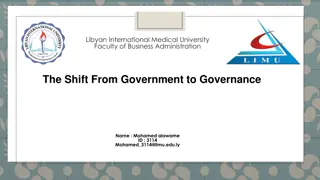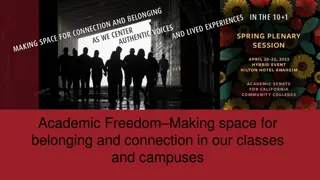The Significance of Faculty Shared Governance and Faculty Senates in Higher Education
Faculty shared governance and faculty senates play a crucial role in creating a positive learning and working environment for students, staff, faculty, and administrators on college campuses. By facilitating communication, resolving conflicts, and providing support, these bodies contribute to enhanced educational opportunities, community building, and overall well-being. The 1966 statements underscore the pivotal role of faculty in decision-making processes and emphasize the collaborative relationship between faculty and institutional leadership in achieving academic goals.
Download Presentation

Please find below an Image/Link to download the presentation.
The content on the website is provided AS IS for your information and personal use only. It may not be sold, licensed, or shared on other websites without obtaining consent from the author. Download presentation by click this link. If you encounter any issues during the download, it is possible that the publisher has removed the file from their server.
E N D
Presentation Transcript
Faculty Shared Governance and Faculty Senates' Significance Brian L. Evans, PhD Faculty Senate President, The University of Texas at Austin, 2019-2020 Interim President, Texas Conference of the American Association of University Professors aaup.texas@gmail.com February 13, 2024 Speaking for myself as an individual Not speaking on behalf of any group, institution, or organization
Faculty Shared Governance Has power to make the campus a better place to learn, work, and play for students, staff, faculty, and administrators Help improve learning & growth opportunities for all on campus Build better climate, relationships, and communities Foster better communication, hear out disagreements, and resolve conflicts Help provide safe & supportive environments for all on campus Health care, food security, and safety Academic support and professional development Example: Fall 2019. UT Austin Counseling & Mental Health Center.
1966 Statement on Government of Colleges and Universities (3500 words) Jointly formulated by Faculty (AAUP), Presidents (ACE) and Regents (ACB) American Council on Ed. (ACE): 1500+ institutions including UTRGV & UT System Assoc. of Gov. Boards of Univ. & Colleges: 1300+ members including UT System Faculty have primary decision-making authority in Curriculum, subject matter, and methods of instruction Those aspects of student life which relate to educational process Matters related to faculty status appointments, reappointments, decisions not to reappoint, promotions, granting of tenure, and dismissal President should exercise adversely only in exceptional circumstances, and for reasons communicated to the faculty & receive faculty feedback Faculty have authority in financial exigency and program closures 1966 Joint Statement, https://www.aaup.org/report/statement-government-colleges-and-universities
1966 Joint AAUP/ACE/AGB Statement on Government of Colleges and Universities President shares responsibility in Definition and attainment of goals Administrative action Communications to link components of academic community President provides institutional leadership Innovate, initiate, and persuade others to work toward goals Utilize judgments of the faculty and outside competent scholars Ensure standards and procedures conform to policy established by the board and standards of sound academic practice Manage and create resources President represents institution to public 1966 Joint Statement, https://www.aaup.org/report/statement-government-colleges-and-universities
1966 Joint AAUP/ACE/AGB Statement on Government of Colleges and Universities Maintains a general overview of the institution Entrusts conduct of administration to administrative officers Entrusts conduct of teaching and research to the faculty Publishes codified statements defining policies and procedures Provides long-term resource planning and oversees endowment Obtains capital and operating funds Supports institution when ignorance or ill will threatens any part In grave crises it will be expected to serve as a champion. Governing Board Roles 1966 Joint Statement, https://www.aaup.org/report/statement-government-colleges-and-universities
2016 UT System Faculty Advisory Council Shared Governance White Paper 1. An institution-wide commitment to the concept of shared governance linking the president, faculty, and all stakeholders in a well-functioning partnership, purposefully devoted to a clearly defined and broadly affirmed institutional vision. 2. An organizational culture of caring, mutual respect, and trust. 3. Consistently open, bidirectional, and transparent communication without threat or fear of reprisal. 4. A standing elected faculty governance organization recognized institution-wide as the voice of the faculty. 5. Partnership, shared responsibility, and shared accountability in decision-making for all academic, clinical, and research matters . 6. A proclivity for action and persistent follow-up on all institutional decisions. 2016 UT SysFAC Statement, https://wikis.utexas.edu/download/attachments/141739715/FINAL%20version%20UTS%20FAC%20White%20Pap er%20on%20Shared%20Governance_.pdf
American Association of University Professors AAUP founded in 1915 by faculty and has 45,000 members. AAUP champions academic freedom, advances shared governance, and organizes all faculty to promote economic security and quality education. AAUP affiliated with the American Federation of Teachers (1.7M members including 148,000 professors) Aug. 2022
1940 Joint AAUP/AAC&U Statement of Principles on Academic Freedom & Tenure (2600 words) Amer. Assoc. Colleges & Universities (AAC&U): 860+ institutions Academic Freedom for teachers consists of interrelated elements freedom to explore all avenues of scholarship, research, and creative expression and to publish the results of such work freedom to discuss all relevant matters in the classroom freedom from institutional censorship or discipline when speaking or writing as participants in the governance of an educational institution freedom from institutional censorship when speaking or writing as a citizen Free inquiry, free expression, and open dissent are critical for student learning and the advancement of knowledge Safeguards include tenure, due process, shared governance 1940 Statement: https://www.aaup.org/report/1940-statement-principles-academic-freedom-and-tenure
UT Regents Rule 31004: Rights and Responsibilities of Faculty Members Sec. 1 Freedom in Research. Faculty members are entitled to full freedom in research and in the publication of the results. Sec. 2 Freedom in the Classroom. Faculty members are entitled to freedom in the classroom in discussing his or her subject, but are expected not to introduce into their teaching controversial matter that has no relation to his or her subject. Sec. 3 Clarification of Role. Faculty members are citizens, members of learned professions, and officers of an educational institution supported by the State of Texas. When the faculty member speaks or writes as a citizen, he or she should be free from institutional censorship or discipline, but should make it plain that the faculty member is not an institutional spokesperson . RR 31004: https://www.utsystem.edu/board-of-regents/rules/31004-rights-and-responsibilities-of-faculty-members
Faculty Shared Governance Has power to make the campus a better place to learn, work, and play for students, staff, faculty, and administrators Help improve learning & growth opportunities for all on campus Build better climate, relationships, and communities Foster better communication, hear out disagreements, and resolve conflicts Help provide safe & supportive environments for all on campus Health care, food security, and safety Academic support and professional development In departments, colleges, and university-wide
Faculty Senate Membership Faculty Senators elected by the faculty Faculty Senators represent faculty to the administration Deans, VPs, Provost, and President as ex-officio members Who is invited to Faculty Senate meetings? How to include student and staff voices? Faculty Senators represent academic units What about faculty senators to represent tenured faculty? Non-tenured faculty?
Faculty Senate Resources @ UT Austin Staff Support 2 full-time administrative staff 1 half-time IT staff - elections, meetings, staff support, web pages, etc. Support for Officers President - 50% time administrative appointment. Reduction in teaching load of two courses. $15K discretionary funding for summer support or other uses. Secretary - Same as President. President-Elect - 25% time administrative appointment. Reduction in teaching load of one course. Past President - same as President-Elect
Example Faculty Senate Standing Committees Academic Freedom Faculty Grievance Faculty Workload and Compensation ** Academic Calendars ** Educational Policy ** Research Policy ** University Budgets ** ** Include administrators whose portfolios are aligned with committee as ex-officio members-- this will help ideas be implemented. Include student/staff government reps.
Example Joint Faculty Senate Provost Task Forces Faculty grievance policy revision COVID grading policies (Mar. 13-26, 2020) Academic calendar modification Course evaluation survey redesign Financial exigency policy (2015-2020) Examples @ UT Austin Natural to draw faculty members from relevant standing committee members and Faculty Senate Executive Committee
Auxiliary Orgs to Help Faculty Senate AAUP members on campus Gives training on AAUP principles of academic freedom and shared governance Works with Faculty Senate to influence changes to campus policies Encourages members to run for Faculty Senate UT System Faculty Advisory Council association of Faculty Senates of all UT campuses Texas Council of Faculty Senates association of Faculty Senates of all 38 public universities
1940 Joint AAUP/AAC&U Statement of Principles on Academic Freedom & Tenure Free inquiry, free expression, and open dissent are critical for student learning and the advancement of knowledge Tenure provides the conditions for faculty to pursue research and innovation and draw evidence-based conclusions free from corporate or political pressure Tenure is an indefinite appointment terminated only for cause or extraordinary circumstances such as financial exigency All full-time faculty members, regardless of rank, are to be considered eligible for tenure 1940 Statement: https://www.aaup.org/report/1940-statement-principles-academic-freedom-and-tenure























